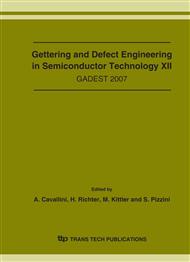p.189
p.195
p.201
p.207
p.213
p.219
p.225
p.233
p.241
Peculiarities of Dislocation Related D1/D2 Bands Behavior under Copper Contamination in Silicon
Abstract:
In this paper we present a detailed investigation of peculiarities of dislocation related D1/D2 bands behavior in silicon doped with Cu. For this purpose float zone grown (FZ) p-type silicon with B-doping 2.85·1015cm-3 was deformed by 3-point bending method at 950flC up to dislocation density of 2±0.2·106 cm-2. The deformed samples were contaminated with Cu up to several concentrations from 6·1013 cm-3 to 5·1016 cm-3. The variation in dislocation related spectra were traced after different thermal treatments. A decrease of D1/D2 bands intensity in quenched samples was observed even after their storage at room temperature. Taking into account the fact that Cu has a high mobility even at room temperature the decrease of D1/D2 bands intensity can be attributed to passivation of corresponding luminescence centers by Cu atoms. The influence of Cu contamination on D2 band is much more complicated as compared to D1 band. New line in position about 883 meV was observed as a result of storage of samples at room temperature and subsequent isochronous anneals. It was observed that D1/D2 band luminescence sharply increased in 30K – 50K range in samples with high Cu doping level. In addition the line in about 830 meV position became stronger at these temperatures whereas its intensity was negligible at 6K.
Info:
Periodical:
Pages:
213-218
Citation:
Online since:
October 2007
Authors:
Keywords:
Price:
Сopyright:
© 2008 Trans Tech Publications Ltd. All Rights Reserved
Share:
Citation:


